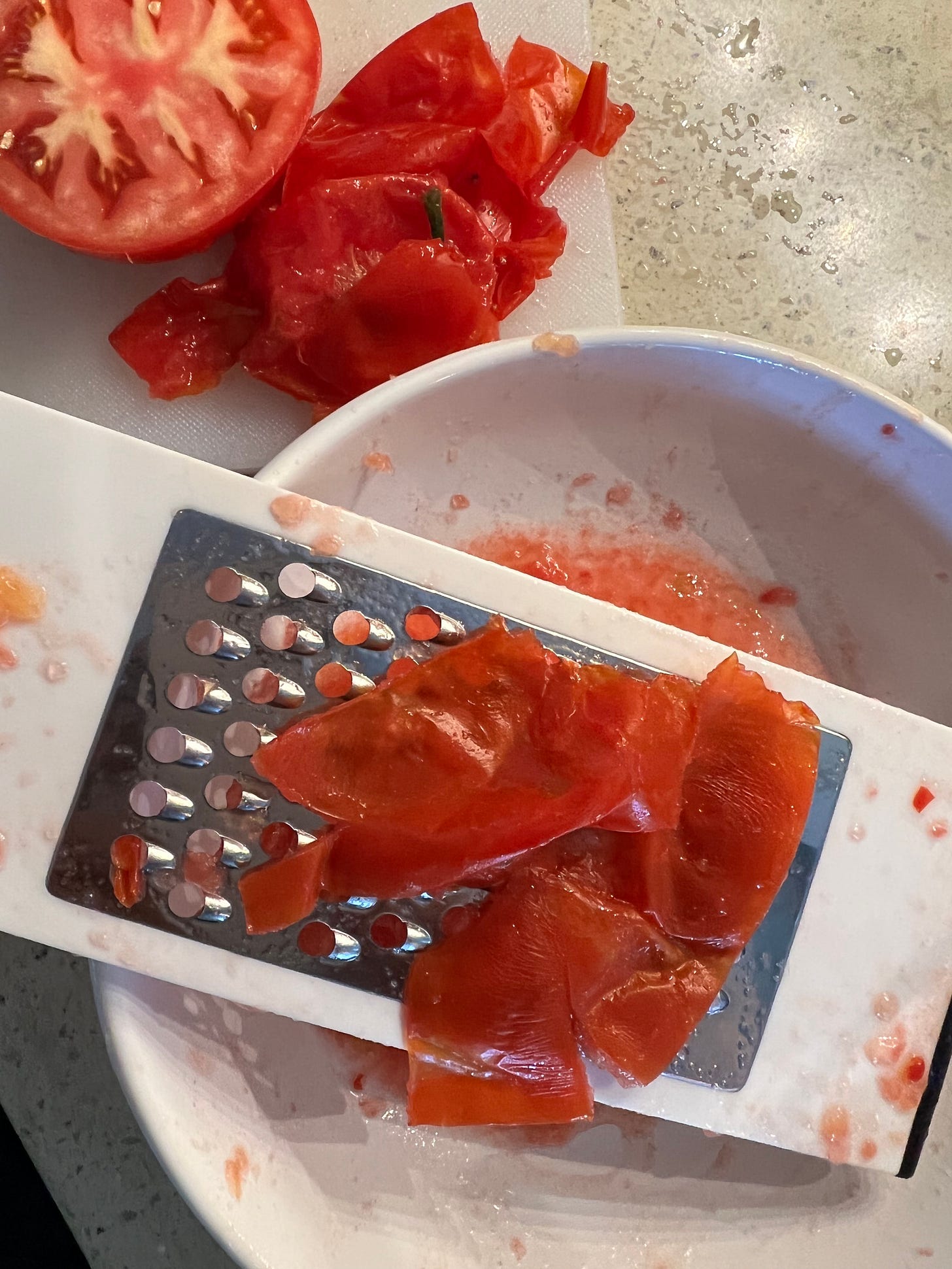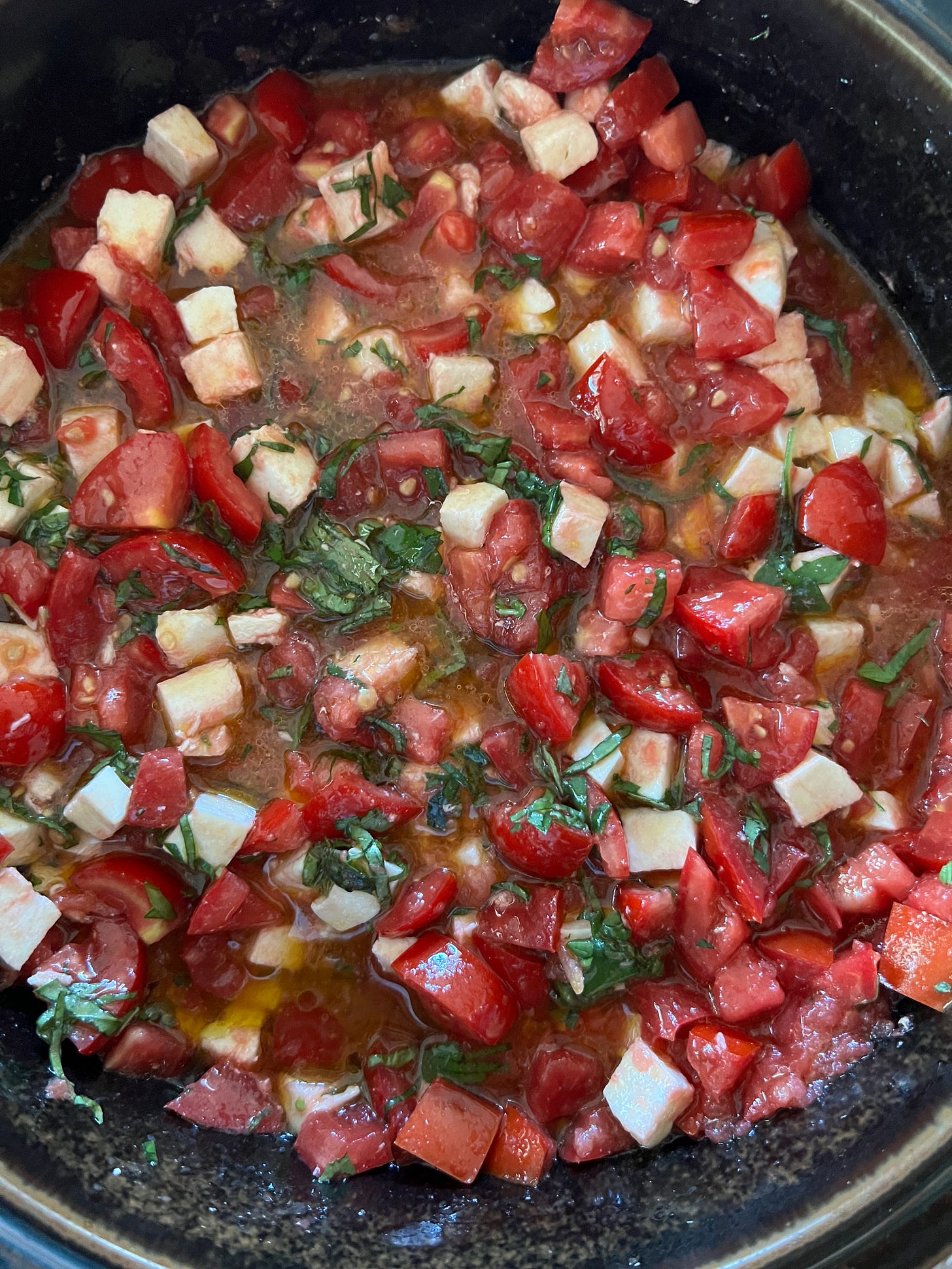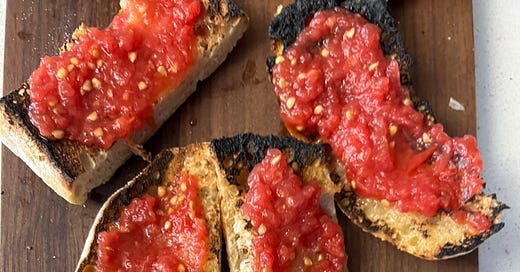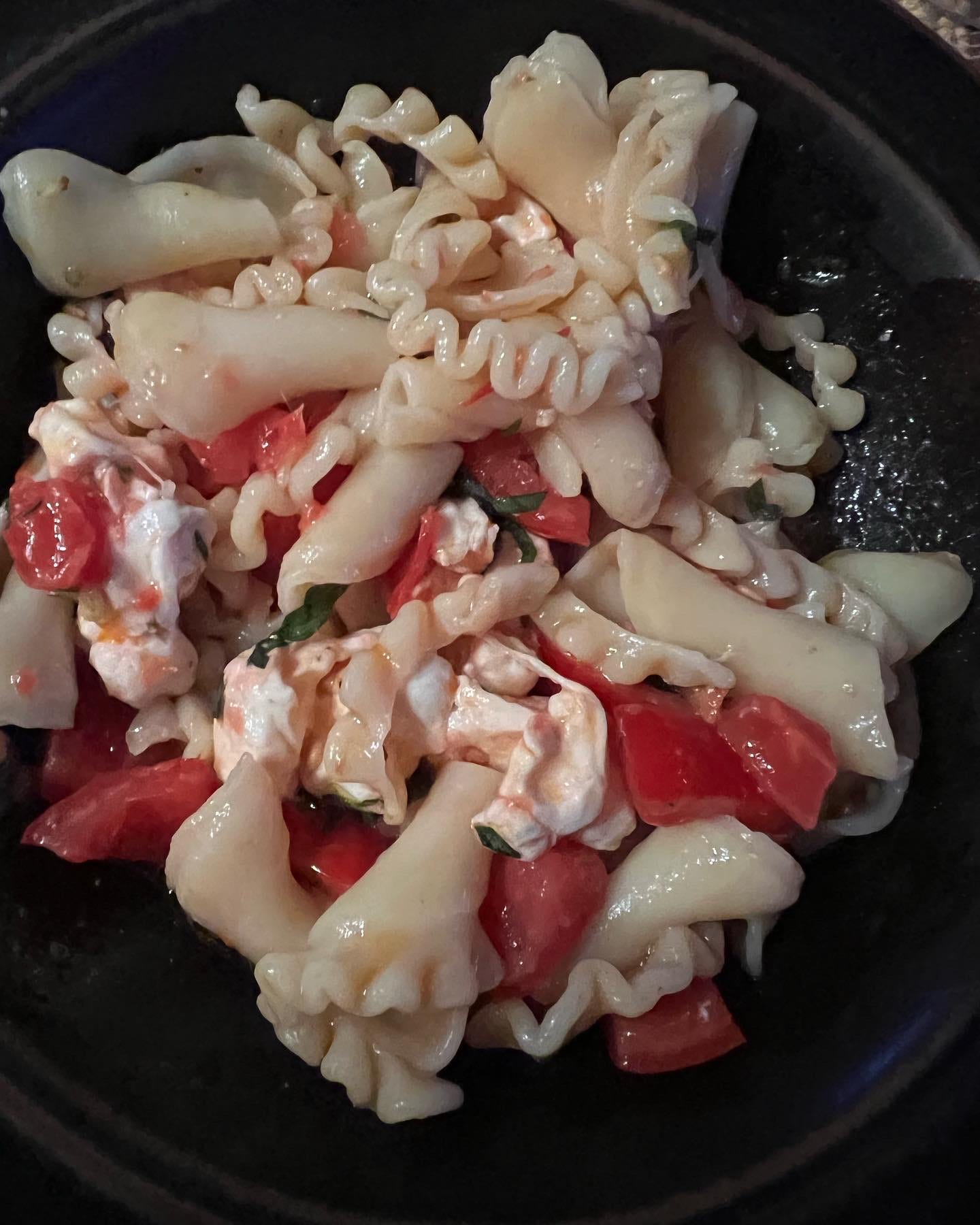Issue #65: Tomato Time
Now, Very Now, Celebrate the Golden Apple in All Its Glory—Recipes for Spanish Tomato Bread and an Un-Cooked Italian Tomato Sauce
Thank you for your continued interest in Kitchen Sense. I so appreciate when subscribers share the newsletter with family and friends. Please encourage those who like it to sign up. Last week I heard from so many people who recalled versions of pepper steak they knew and loved. Several made it for the first time in years. This week paid subscribers received a lagniappe in the form of my London Notebook, chockablock with recommendations on where to eat based on two recent visits. While I will always keep my recipes and cooking information free to everyone because I believe we all owe it to ourselves and to our planet to know how to cook, from time to time I offer paid subscribers who are supporting this effort a few special treats, usually about eating out. London joins Paris and Tel Aviv as destinations through which I will help you eat your way.
Also, this week, you can listen to the latest episode of my podcast What’s Burning, for which I interview polyglot chef Ivan Broehm about the “crossroads cuisine” he serves at his restaurant Nouri in Singapore. We go deep on the subject of running a mindful restaurant, discussing how to build a supportive culture in the kitchen while instilling curiosity among cooks. What’s Burning is produced by the Jewish National Fund USA and the Galilee Culinary Institute.
I know that I’m beginning to sound like a broken record, but I’m still playing catch up (ketchup?) in the garden. First zucchini, then peppers. Now it’s tomato time. These “golden apples” (pomodori in Italian) are piled high on my counter awaiting their fate. (Meanwhile, I still have a few giant zucchini and a peck of peppers in the fridge to deal with.) It’s a race to see whether I can use them all before they rot. I scan for mold every morning.

While I appreciate the variation and variety of heirloom tomatoes, not to mention their visual and gastronomic appeal, I have to say that I’m doubling down on my love for the good ol’ American beefsteak. You know the common, big, heavy, juicy, bright-red tomato you see in markets at this time of year, one slice of which can fill an entire sandwich. Here in New York, you find them often labeled “Jersey Tomatoes,” because a particularly flavorful, fleshy subset of beefsteak varieties was developed by Rutgers University for and cultivated widely by the Campbell’s Soup Company, based in Camden, New Jersey.
When fully ripened on the vine, beefsteaks have an almost stereotypical fresh tomato taste. What’s more, they are relatively inexpensive. They are not as meaty as San Marzanos and they don’t have that cooked, tomato-sauce taste of other Italian vine-ripened varieties. But I love them, nonetheless, and these days I have so many I can experiment and eat my fill.
Through experimentation I’ve come to really appreciate the Mediterranean home-cook technique of grating tomatoes on a flat or box grater to separate the flesh from the skin. Grating produces a rich, tomatoey pulp, that I find much easier and quicker than blanching and peeling. Plus, it allows you to make as much or as little tomato pulp as you need.
This pulp forms the basis of Spain’s beloved pan con tomate, and it’s ideal to make a quick tomato sauce. I know some cooking “experts” will advise you against using fresh tomatoes for a sauce, especially beefsteaks, claiming canned tomatoes have more flavor. While I love good canned tomatoes, too, in tomato season it seems a crime to open a can. A gentle simmer is all you need to concentrate the flavor of the beefsteak pulp for a tasty fresh tomato sauce.

In fact, when tomatoes are as good as they are right now, you don’t even need to cook them to make a delicious sauce for pasta. Years ago, I was working on a proposal for a book with Egidiana Maccioni, wife and co-owner with her husband Sirio of New York’s famed Le Cirque and Circo restaurants. Egi was renowned for her Tuscan cooking, which was to be the subject of our proposed book, and we spent several weeks cooking together in their family home in Montecatini Terme. One hot summer’s day, Egi made a pasta for lunch she called salsa cruda tiepida, or “raw, room-temperature sauce” (like many things, it sounds better in Italian). Think of a caprese salad turned into a sauce for pasta. It consisted of plenty of chopped, ripe, fresh tomatoes, fresh mozzarella, also chopped, shredded basil, sea salt, and a Tuscan’s measure (meaning a lot) of fine olive oil. Egi mixed everything together in the morning and let it sit on the counter to macerate until lunch. When the time came to eat, she cooked some dried pasta al dente and tossed it hot into the room temperature sauce along with some of the cooking water. As everything was mixed together, the cheese melted slightly and the noodles soaked up the tomato juice that had pooled in the bowl. Che buona.
My collaboration with Egi didn’t get off the ground, but my Tuscan repertoire expanded considerably. From that experience and many others, I offer you two ways to use the fresh, field-ripened beefsteak tomatoes that you should be able to find just about everywhere right now. As soon as they are gone, put these recipes away and bring them out next year at tomato time.
RECIPE: Pan con Tomate
Ubiquitous in Spain—year-round, it should be noted—these tomato toasts are my go-to hors d’oeuvre in the height of tomato season. A light, airy, crusty bread like ciabatta is ideal to hold the tomato pulp. You should cut through the whole loaf to get thick slices you then split in half crosswise. Use a broiler or grill to char the bread—if a corner or two catches fire, just blow it out.
(Serves 4 to 6)
1 or 2 large, ripe beefsteak tomatoes
Sea salt
8 wide slices ciabatta or similar airy, crusty bread, cut straight through the whole loaf
Extra-virgin olive oil, the best you can afford
1 clove garlic
Slice the tomato(es) in half horizontally. Using the wide holes of a box grater set over a wide bowl, press the cut half of the tomato against the grater with the flat of your four fingers and move it up and down to remove the pulp from the skin. Some folks recommend using your palm, but I find with my flattened fingers I have more sensitivity to what’s going on beneath and I can press the skin against the grater with more precision to remove all of the flesh. Repeat until all of your tomato halves have been grated. Add a pinch of salt to the pulp, mix, and set aside.
Preheat a broiler or grill. Cut the bread slices in half horizontally through the center, as though you were going to make a sandwich and open them up, crust side down. Arrange slices on a baking tray. Drizzle with a decent amount of olive oil and use a brush to even it out. Sprinkle the bread with salt. Set the bread crust side down under the broiler or crust side up on the grill (the crumb should be facing the flame). Watch it closely, moving the bread around until the bread toasts, the edges begin to char, and it is heated through. If a corner catches fire, just blow it out. When evenly “toasted,” set the bread cut side up on a platter.
Split the garlic clove in half and using the cut side, rub the halves all over the warm bread. This will impart a remarkably pronounced garlic flavor. Note, due to the oil and char, this process can be messy. Once the bread is sufficiently garlic-rubbed, spoon the seasoned tomato pulp on top and serve.
RECIPE: Pasta con Salsa Cruda Tiepida al Pomodori e Mozzarella or Pasta with Ripe Tomato and Mozzarella
This is the rare Italian pasta dish that is served at room temperature rather than piping hot—Italians are puzzled by the American fascination with pasta salad—which makes it refreshing on a hot summer’s day. Like many of the best Italian dishes, this one has very few ingredients, and so it behooves you to find the best you can afford. Only make it in the height of tomato season.
(Serves 6)
2 or 3 large, ripe beefsteak tomatoes (about 2 pounds)
12 ounces fresh mozzarella (di bufala, if you can find it)
½ cup fresh basil leaves, shredded
1/3 cup extra-virgin olive oil, splurge on a special one
Sea salt
1 pound dried pasta, a small, curly shape, such as gilli, cornetti, campanelle, or trompette, which are different names for the same trumpet shape, casarecce, shells, or similar
Freshly ground black pepper
At least a couple of hours before you intend to serve the dish, cut up your tomatoes into 1/4-inch dice and place them in a large serving bowl. Be sure to capture any juice that runs off. Dice the mozzarella the same size as the tomatoes and combine. Add all but a pinch or two of the basil (which you are reserving for garnish). Pour in the olive oil, add a generous pinch of salt, and mix well. Let sit on the counter until you are ready to serve.

About 15 minutes before you are ready to eat, cook the pasta. When it reaches al dente, scoop ½ cup of the cooking water out of the pot and drain the noodles. Do not rinse. Add the noodles to the tomato sauce along with that reserved cooking water, a generous amount of freshly ground black pepper, and another pinch of salt. Mix well and keep mixing until the sauce, especially the mozzarella is evenly distributed and you can see it is beginning to melt. Let sit a few minute so the noodles absorb some of the juices, divide among bowls, top with a sprinkle of the reserved basil, and serve.




